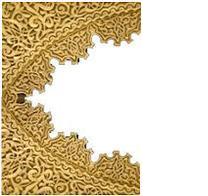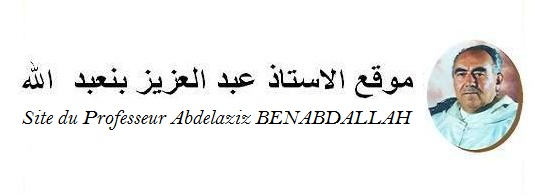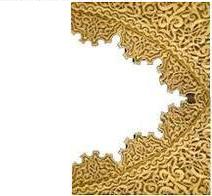|
|
|
Questions-Responses on Sufism |
(Translated into English by Mr Taoufiq GAZOULIT) |
Authenticity of Islamic Sufism
3- QUESTION : I am looking for a spiritual master in Geneva, is this necessary? What is your advice?
3- ANSWER : I do not know of any spiritual master in Geneva, as the need for a counsellor of this kind. The Sufis are unanimous about it.
10- QUESTION : I would like to have some knowledge of the El Qadiria order. 10- ANSWER : The Qadiria order is the path established by the great Sufi Sidi Abdelkade JILANI whose grave is in Iraq. He is a big Sheikh considered by the eminent scholar IBN TAYMIA, being the most prominent in the category of Sheikhs in Islam. Most of the marabout orders refer to this sunnit sect because of its source and the high dignity of its promotor. Not one of the Fatwas of IBN TAYMIA, among those of around 30 works in this particular case does not counter the caracteristics and the aunthenticity of this Sheikh, considered by the promoter of the Tijania order as one of the most eminent poles of Islam. 15- QUESTION : I would like to begin to study Ibn Arabi’s work “Sheikh al akbar”, but after several attempts of direct reading of the work, I had to give up because of the complexity and the difficulty of the ideas which are developed. Would you be kind enough and indicate to me a book in French which can introduce me to his work? ADDAS Claude’s book called “Ibn Arabi, ou la quête du souffre rouge” Paris: Gallimard 1989. Would it suit me? I would like to thank you for your help and attention. 15- ANSWER : In addition to the work which you quote, you can consult the work of Henry Corbin entitled “the creative imagination at Ibn Arabi”. It is a work of Shiite tint but very deep. It could balance itself with Claude Addas’s work. I had the pleasure to have read both.
16- QUESTION : Could you tell me accurately a technique of Dikr that I can follow ? I sometimes practise it but I do not know exactly how nor which form to use ...?
16- ANSWER : The best Dikr is the recitation of the Koran, especially three surats: “the Fatiha” which amounts according to a hadith to the whole Koran. Two other suras of which one is called “sura of fate” and which amounts the middle of the Koran. The third sura is called “sincerity” and is the equivalent of a third the Koran. Among other known Dikrs, the “Hilala” (La ilaha illa Allah) and the similar prayers such as “salat ala nabbi” (blessing of the Prophet).
26- QUESTION : What does Islam say about music and dance ?
26- ANSWER : In my work in Arabic entitled “encyclopaedia of the Islamic Sufism between the West and the occident” published in 3 volumes, I have reserved a substantial study on music and dance, such as they are conceived and often legitimized by the Sheikh Tijani, when they are loosened of any eccentric elements, from which I quoted some specimens.
35- QUESTION : We are interested in qassayd el madih. We would appreciate your help on our approach, if you can. We are brothers of the naqshbandi order. This approach is personal. We have visited your website about the tijani order.
40- QUESTION : I am a brother from Africa. I would like to know the meaning of “Hizb Alsayfi” in French ? 40- ANSWER : The Hizb has 2 meanings: the party (partisan group), or prayer (dikr). Its significance in this case is “prayer of the sword” meaning “sharp prayer”, otherwise efficient or lightning dikr. This hizb was elaborated by the great andalusian Sufi Ibn Arabi. It is a prayer with a dozen pages. Its recitation can be replaced according to the grand sheikh Sidi Ahmed Tijani by reading “sura alqadr” (sura of destiny) 41 times.
54- QUESTION : I would have loved to write this message to you in Arabic, as it would allow me to better formulate some questions that I hope you will kindly answer. Unfortunately, my computer does not allow it. Firstly, I would like to thank you and congratulate you for the extraordinary efforts you make, in order to diffuse via the internet the Encyclopaedic knowledge given to you by Allah, as well as the pure Islamic cause, as you mentioned in one of your interviews. I would like to let you know about a dream where I saw the prophet Sidna Mohammed, which caused a feeling of euphoria inside of me, which remained one or two days after the evening of the dream. This is the dream: I saw Khairan Wa Salaman in central Houston, USA (I spent some time in this town four years ago). I was with a non identified friend in this dream. We were talking about the authenticity of one hadith Sharif. I said that this hadith is authentic and my friend disagreed, which was said loudly. I noticed a radiant person whom I identified as the prophet Sidna Mohammed. So I said to my friend: “this is the prophet himself. We will ask him if this hadith is his or not.” We approached him but I could not see his face, as he was radiant. I then took his hand and kissed it with enthusiasm and a strong “HAL” took hold of my entire body. This state of mind remained until morning… I had totally forgotten to enquire on the hadith and simply asked my friend to draw the Baraka. I have to tell you that, like a big number of people of my generation, although I am a believer, I did not pray and I went back to the religion considering it as the foundation of my life philosophy at the age of 42, particularly through my reading about “Tassa Wuf”. Since this dream, the quality of my prayers has changed. I concentrate and do my prayers on time. I would like to find out how Sufis interpret dreams. When Sidna Mohammed appears, is there any link with the initiatory trip in the sense of “Soulouk” term? I ask you this because days following this dream, I was profoundly preoocupied by the thought of looking for a Sheikh Aref Bi Allah. Without him, would a person have never truly know Allah ? 54- ANSWER : When it is felt by the dreamer, the vision of the prophet in the dream cannot be a nightmare. A genuine hadith specifies that Satan cannot be part of a dream about the prophet. Another hadith underlines that a vision whilst being asleep will always be reinforced the day before. This prophetic vision is often a reminder to the believer to follow Islam properly, as you have experienced yourself.
56- QUESTION : Je suis en train de lire votre livre " Le Rationnel du Sacré " qu'un ami m'a ramené du Maroc. Je suis très intéressée par les trois monothéismes et le soufisme et votre livre me passionne. I am reading your book “the rational coronation” that a friend brought me back from Morocco. I am very interested in the three monotheistic religions and Sufism and your book fascinates me. I am currently working on the symbolism of the door, but I have not yet found anything related to this symbol in Islam. Could you help me or tell me where I could get information ? 56-ANSWER : It is always among the Muslim believer to refer to the sublime Door of the divine presence, where the initiated believer sees his initiated archetype stand out. This notion is reflected on the front door of Islam or the Ottoman Empire, which oversaw for a good part of the Middle Ages the entire Islamic world. This door of the Presence is the sublime access of Sufi, when it will rise higher in the hierarchy. Here in this forum, esotericism meets exoterism, meaning the somato-psychic harmoniously combines itself with a certain philosophy where the interior incorporates, with the first, a symbiosis. A conference of high-ranged technicians, amongst the great physicians, took place in Tokyo in 1966. These studies result in an extraordinary observation where the electron, located in the matter, indubitably refers to another electron, the one of the spirit. In this sublimely human symbiosis, the 2 components, considered contradictory, are only complementary to one another. Refer to my piece of work named “Islam in its sources”, chapter named “The spirituality of the matter”.
59- QUESTION : We are looking for documents or books on Sheikh Hamallah, born in the Nioro (Senegal), deported dead in France and buried in Montluçon in 1949. 59- ANSWER : Please refer to the institute IFAN in Dakar for a list of articles and studies on the biography of this character.
61- QUESTION : I am interested in Sufism but I still have not understood the origin of this spirituality and the origin of the word. 61- ANSWER : There is no unanimity as to the origin of the word Sufism. I have kept a whole chapter on this theme in my book in Arabic “Encyclopaedia of Sufism”. We have mentioned a few possible origins, such as the “souf” (wool), which is the clothing of the soufis. We also mentioned the “Ahl Souffa” (the Prophet’s group of single companions accommodated in the big mosque of Medina).A to the notion of spirituality, it is no different in its ultra-human background of Islam itself, such as it is planned in the sounna and that has the temporal, the psychic and the spiritual.
64- QUESTION : I would like to know the whereabouts of the passage in which IBN ARABI mentions the fact that there were 40 Adams before the Adam we know (the rational of the sacred)? Is there even an apocryphal hadith hinting it ? 64- ANSWER : This reference to IBN ARABI, concerning the question you brought up, and that I have mentioned in my book “The Rational of the Sacred”, exists of course, although I do not remember where I saw the text. This Hatimite subject can seem sort of eccentric; all the more that IBN ARABI is the only one to have asserted it. But the Koranic text itself, quoted in the same text, seems to be the start of proof. If we ascertain the term “Safaka”, it can concern an animal or a human, or be similar, abstraction of all other angelic elements or geniuses. (See our article on Darwinian thoughts).
85- QUESTION : I would like to enter an order, but my husband will not allow me. What can I do ?
How to become a disciple of the order ? Are men and women separated during the meetings ? Do you know where the sisters meet in the region of Paris ?
91- QUESTION : I am interested in the messianic thinking, its nature and the link establishe between the temporal and spiritual. The “exteritorialisation” involves an event to come, which constantly transforms the present to a sort of reversal of time and being. It is pretty confusing right now, the difference between a healthy messianic, which calls for the transformation of self and the spiritual journey. There is a messianic thinking, both in sohrawardi than in Ibn’Arabi and in the contemporary world at Mahmud Taha. I am therefore trying to understand what could be the guidelines of messianic thinking in Islam, especially after reading a wonderful book of a philosopher that I greatly appreciate: Levinas. He describes the messianic thinking in the Jewish religion, which is his own religion. So what are the guidelines of a thought of the messianic event in Islam? I have found an early response in your book “the rational of the sacred” in the second chapter of the same book. 96- QUESTION : Can we (as this often happens) give permission to recite certain invocations by internet ? 97- QUESTION : Where does the litany Hizb Sayfi come from? I read somewhere that it was inspired to cheikh rifa’I that God would mercy him ?. 99- QUESTION : Who is the seal of the Mohammadian saintliness ?
104- QUESTION : What’s the origin of "ism al jalala" ?
107- QUESTION : I’ve read with great interest questions and answers on your website. I looked in vain on the internet about the meaning of dalil al Khirat, which we recite in certain ceremonies. Would you clarify this for me ? 109- QUESTION : First, I would like to thank you for the effort you make as to enlighten us. I witnessed that you often us the word “sect” in certain questions and answers (for example, Tijani sect and qadiriya sect). I’m French converted to Islam and in France the word “sect” has a negative connotation. Does it have the same meaning when you use it? I would also like to know about the presence of Tariqa naqshbandiya in Morocco and in Senegal.
127- QUESTION : Is Al-Khidr still alive? And who was he? Was Moussa’s companion (Yuchah Ibn Noun buried in Istanbul) a saint? How do you qualify his relationship with Sidna Moussa ?
134- QUESTION : I am a student from Senegal living in Lyon in France. The content of your website is so rich and your open spirit as to answering questions concerning different subjects incites me to ask you several questions about Sufism. So if you allow me, here are some questions: how would we know if a person is a “wali” or not? There are so many Sheikhs around us and I do not know to whom I may go and talk to. Is there any practical way to find out about the order which suits us better, or to meet the best Sheikh in order to help us find the right path ? I have heard a hadith that upsets me, saying that every 100 years, a man will appear and renew this religion. Is this hadith genuine ? If so, then who is the present person ?
167- QUESTION : I had a dream which incited me to pray more about Sidna Mohamed (peace be upon him). How many times do I have to do this prayer and how ?
171- QUESTION : I would like to know which of these two Salats is the closest to the suna: “ALLHUMMA SALLI ALLA SAYYIDINA MUHAMMAD ANABBIY AL OUMMIYI WA ALA ALIHI WA BARIK WA SALLIM” and “ALLAHUMMA SALLI ALA SAYYIDINA MUHAMMADIN WA ALA ALIHI WA SAHBIHI WA SALLIM".
177- QUESTION : Firstly, I would like to thank you for creating this website, to allow everyone to learn. I would like you to explain to me in what consists the Hizb Sayfi and its content, using the Latin transliteration if possible. In any case, I would like the Arab transliteration if you could give it to me.
197- QUESTION : Whilst I was doing a prayer about the Prophet (psl) 300 times, I felt attracted by a state that scared me because I was attracted to an unknown state. This is the second time it has happened to me. The first was so strong that I had to pray to God that the intensity would calm down. How could you explain this and what to do ?
198- QUESTION : Whilst dreaming, I saw Foudayl Ibn Ayad. I would like to know why me, what relationship links us and what did he want from me? In fact, I would like to know the consistence of the process of a call to a saint ? 218- QUESTION : Who are the Malâmitiya? Whats is their grade in the Soufis concert ? 218- ANSWER :The real Malâmitiya are those who are depicted by the author of the elaborated work in the IV century of the first era of the hegira, called “el Foutouwwa wa el Malâmitiya”. Abou Bekr, the Prophet's first Khalife, was the ideal model, of which Sidi Larbi Ben Sayeh, author of the “Boghia”, cites the privileges characteristics. Samân el Fârissi (Persan), the Prophet's famous companion, is listed as one of the best of these initiated of which the decent exoterism covers the interior’s luminescence. The Prophet valued him a lot and considered him as a member of his own family. Ibn ‘Arabi intergrated them into a category that no act (surerogatoire) distinguishes the outbuildings of the believers. Even better, they try to act normal to not attract attention because they isolate themselves inwardly in the contemplation of God without marking themselves down by excentric behaviour. Each of them go about their work without pretentious exclusism. They don’t have any privileges or specific rights. Apparently, craftsmen are absorbed by their work, artists in their workshop, and labourers in their work, where as some of them master the Cosmos by their sublime hierarchy grade. With time, this category, attached to the Sounna in its deferent humility, knowingly changes tactics whilst exhibiting excentricities to be underestimates by the world. Also, not knowing the mobile initiators of the behaviour of their master, the disciples, in their ostentation, let themselves get carried away by schemes that are far from the usual ways, sometimes denoting obvious strangeness.
|


